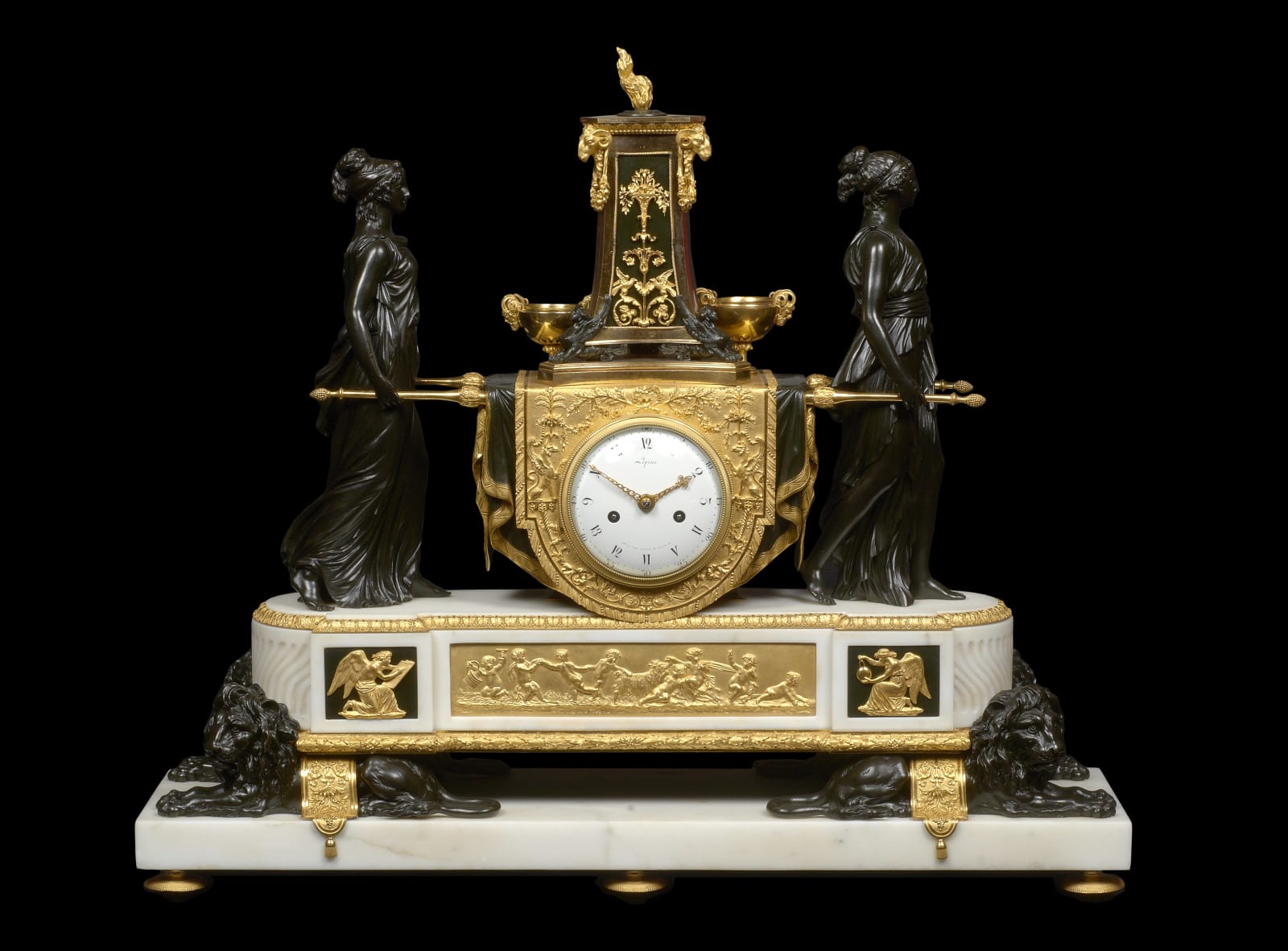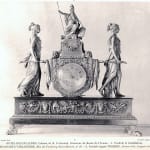
Ambasse D'Angleterre, Rue Faubourg Saint-Honoré, no. 39, Pendule signée THOMIRE.
Pierre-Claude Lépine (Raguet-) French, 1753-1810
Provenance
Sotheby’s London, 21st June 1988, lot 19. Lily and Edmond J. Safra.
Literature
Hans Ottomeyer and Peter Pröschel, “Vergoldete Bronzen”, 1986, p. 297, pl. 4.18.5, illustrating a similar clock with case by Pierre-Philippe Thomire and dial signed Sauvageot à Paris.
Tardy, “Les Plus Belles Pendules Françaises”, 1994, pp. 184-5, illustrating a similar clock by P-P Thomire with movement by Robert Robin with Sèvres porcelain plaques in the Musée des Arts Décoratifs, Paris.
Jean-Dominique Augarde, “Les Ouvriers du Temps”, 1996, p. 240, pl. 189, illustrating a similar clock with case by P-P Thomire with Sèvres plaques and movement by R. Robin, in the Corcoran Gallery, Washington.
Pierre Kjellberg, “Encyclopédie de la Pendule Française du Moyen Age au XXe Siècle”, 1997, p. 266, illustrating the example in the Musée des Arts Décoratifs, Paris and p. 267, illustrating a similar clock signed on the dial Manière à Paris.
An important Louis XVI gilt and patinated bronze and white marble mantel clock of eight day duration representing Vestal Virgins Carrying the Sacred Fire, with movement by Pierre-Claude Raguet-Lépine housed in a magnificent case attributed to Pierre-Philippe Thomire, signed on the white enamel dial Lépine Her Du Roy Place de Louis X4 and also signed and numbered on the movement Lépine Hger Du Roy à Paris no 4258. The dial with Roman and Arabic numerals and a fine pair of pierced gilt brass hands for the hours and minutes. The movement with anchor escapement, silk thread suspension, striking on the hour and half hour on a single bell, with outside count wheel. The case with a pair of Vestal Virgins carrying a draped casket housing the clock itself surmounted by a flaming tripod brazier flanked by a tazza and pitcher, the figures and casket on a rectangular white marble plinth with rounded ends centred by a gilt frieze cast with putti flanked by square plaques mounted with the figures of Calliop to the left and Uranie to the right, supported on four reclining lions resting on a white marble base on circular gilt bronze feet
Paris, date circa 1790-91
Height 56 cm, width 65 cm, depth 18.5 cm.
Sixteen examples of this model are known including examples cited above as well as one in the Minneapolis Institute of Art. Five of them are decorated with Sèvres plaques, one of which was included in the 1793 inventory of clocks belonging to Marie-Antoinette; it was delivered to the Queen for her boudoir at Château de Saint-Cloud in 1788 by the marchand-mercier Dominique Daguerre and is now in the Musée des Arts Décoratifs, Paris. Another example was delivered to the Queen’s sister the duchesse de Saxe-Teschen while another with movement by F. L. Godon, clockmaker to the King of Spain is in El Museo Nacional des Artes Decorativas, Madrid. The assumption that Daguerre owned the model is confirmed by a corresponding description in the inventory drawn up after his death which notes: ‘X une autre pendule dite les porteuses mouvement ajusté dans une espece de brancart surmonté d’un petit autel le tout en bronze doré au mat et porté par deux figures de femmes en bronze de couleur antique avec socle de marbre blanc à bas relief porté par quatre roues en bronze noir et sur double socle en marbre bleu turquin.”
The attribution to the pre-eminent bronzier Pierre-Philippe Thomire (1751-1843) is confirmed in an article by Alvar González-Palacios in “Connaissance des Arts”, September 1976, pp. 11-13, in which he cites Pierre Verlet, who discovered documents from the Sèvres manufactory 1788 which note that all the aforementioned mounts for Marie-Antoinette’s clock were provided by Thomire. Furthermore González-Palacios cites other very similar models that are signed by Thomire such as one formerly owned by Pauline Bonaparte-Borghese (now in the British Embassy, Paris). It is believed that all other models of this clock were executed by Thomire. The model itself was derived from an engraving after Hubert Robert, published by the Abbé de Saint-Non in “Recueil des Griffonis”, 1771-73. Jean Démosthène Dugourc (1749-1825), one of the most famous French draughtsmen working in ornamental design during the second half of the eighteenth century is known to have completed a design in 1790 for a clock based on Robert’s engraving, which is probably how Thomire came across the design.
The clock itself was made by the royal clockmaker Pierre-Claude Raguet-Lépine (1753-1810), whose address on the dial at Place de Louis X4 suggests that the clock was made prior to 1793 when Place de Louis XIV was renamed Place des Victoires-Nationaux, while the number 4258 places the present work after the creation of the celebrated Lépine ‘negress head clock’, which is number 4193 and dated June 1790 (as far as known his numbering began with 4000). The latter was purchased by the Prince Regent, later George IV and still remains in the British Royal Collection.
In many respects Pierre-Claude Raguet, known as Raguet-Lépine was as successful and as illustrious as his father-in-law Jean-Antoine I Lépine (1720-1814) with whom he worked in close association and whose business he succeeded in 1784. Born in Dôle, Pierre-Claude married Jean-Antoine’s daughter Pauline in 1782, having already invested 16,000 livres in his future father-in law’s business, he then purchased a third share in 1783 and finally took over the business in June 1784 under the name of Lépine à Paris, Horloger du Roi. Prior to this he had worked as a compagnon to Jean-Antoine I Lépine and then in 1785 was received as a maître. Lépine-Raguet not only became prosperous from his clock productions but also dealt in diamonds and precious stones. His clocks and watches were of the highest quality and as such were supplied to the cream of society, including the comte de Provence and Louis XV’s daughters at Château de Bellevue. He was also a member of the jury responsible for deciding upon a new Republican time system (1793); during the Empire he was appointed Horloger breveté de Sa Majesté l’Impératrice-Reine, 1805 and four years later was titled clockmaker to Impératrice Joséphine while his other clientele included Napoleon I, Jérôme King of Westphalia, Charles IV King of Spain, the princes Talleyrand, Kourakine (the Russian Ambassador) and Schwarzenberg (the Austrian Ambassador).
Such was his success that he needed a large workforce which included a number of his relatives including Jean-Antoine II Lépine, who managed the workshop as well as Jean-Louis Lépine in Geneva and Jacques Lépine in Kassel, Germany. As here his cases were supplied by Pierre-Philippe Thomire and by other leading bronziers such as F. Rémond, F. Vion, E. Martincourt, the Feuchères and Duports while dials were supplied by such fine enamellists as Coteau, Dubuisson, Cave, Merlet and others. Today Raguet-Lépine’s work can be admired in such collections as the Musée du Louvre, Château de Compiègne, the British Royal Collection, Musée International d’Horlogerie at La Chaux-des-Fonds, Deutsches Uhrenmuseum Furtwangen, Schloss Wilhemshöhe Kassel, the Patrimonio Nacional in Spain, the Hermitage Saint Petersburg as well as the Detroit Institute of Arts and Minneapolis Institute of Arts.


